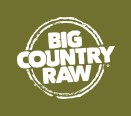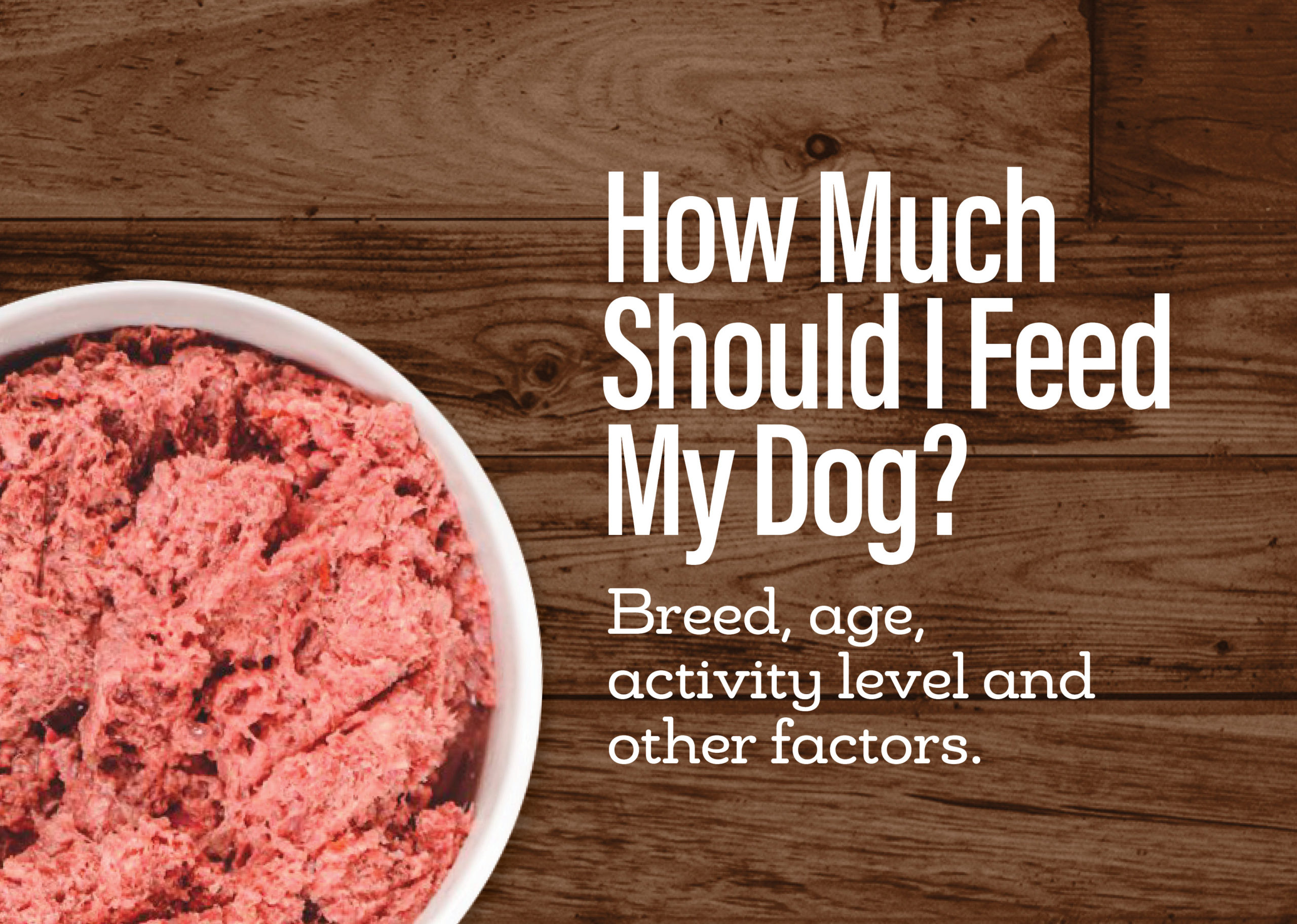By Julie Lauzon, agr, MSc, Pet Nutrition
The percentage of body weight in raw feeding can vary largely depending on multiple factors: breed, age, neutering, calorie content, ingredient ratio, level of activity, treats, amount of carbs in the diet, etc.
The 2% body weight that is shared is an average, based on other averages. An adult dog of a medium breed (30-70 lb) that is not spayed or neutered, that has a moderate level of activity, eating a diet with 10% fruit and vegetable and around 10% fat, will eat approximately 2% of his body weight daily. That is very specific, right? If you dog doesn’t eat 2% of his body weight, you have to ask yourself, what are the differences between my dog and the description above?
Race
There is no surprise when we say that a dog’s breed can bring differences in size, energy level, working purpose, etc. For example, Nordic breeds like Huskies or Malamutes were created hundreds of years ago to be hard working dogs, able to walk and run hundreds of kilometers per day, without the need of a lot of calories or grooming, in the cold. They are built to be able to eat only once a day, or every two days, a small but calorie dense meal. They are built to sleep outside in the cold after a long day of intense physical exercise. These breeds are endurance dogs, with a metabolism that has evolved to rely on small and dense meals. You can’t expect your husky to eat a large amount of food twice a day, they eat to live, and not the opposite. These breeds might eat under 1.5% of body weight.
On the contrary, some other dogs will always seem hungry. Labradors and other hunting or working breeds usually have a larger appetite, even after they have met their daily caloric requirements. These breeds might benefit from less dense meals, with lower calorie ingredients, allowing them to eat more food in weight but not more calories. These breeds will typically eat around 2-3% of body weight or more, if the food is less calories per grams or if they do the job they were breed for. For example, Labradors are especially known for looking like they are starving all day long, that’s simply in their genes. They were born to be able to eat large meals and expend their stomach up to three time the normal size, and put fat on incredibly fast, to resist the cold water or their original country.
Toy breeds and giant breeds are not only opposite in size, but in calorie requirement as well. Very small dogs tend to have a way faster metabolism than giant breed. They burn more energy for the same level of exercise than a giant breed would. Chihuahuas, Yorkshire and Boston Terriers might eat around 3% and even up to 5% of their body weight, while Great Danes and Bullmastiffs might eat around 1 or 1,5% of their body weight.
It is also not rare that dogs prone to anxiety are more affected by environmental stress and can eat as much as 3-4% of body weight daily. The molecule secreted by the anxious state increases the metabolism energy requirement.
In fact, basal metabolism energy requirements (BMR – energy at rest, laying down) can vary from 41kcal to 114kcal per kg of body weight (BW) exponent 0.75. That means, a dog of 25 kg can have a basal metabolism energy requirement varying from 458kcal to 1274kcal depending on breed and genetic components only.
Age and Neutering
In the pet food industry, we often hear “puppy food’’ and “adult food”. That’s a kibble thing – kibble is packed with fillers, therefore brands usually make a denser puppy food, that if you keep feeding the same amount to your adult dog, they will likely put weight on.
At Big Country Raw, we only use fresh and natural ingredients, and no fillers. Puppies and kittens will therefore need to eat more food in proportion to their body weight than an adult dog to get all the nutrients they need. There is no such thing as puppy and adult food, only the amount of nutrients given in proportion to their body weight will change. A growing puppy and kitten will eat up to 10% of their body weight during the first weeks, and slowly decrease during the following months to end up around 2% at 12 months old.
If you are neutering or spaying your dog or cat major changes will follow in their metabolism and one of them is a lower daily calorie requirement. In fact, the energy requirement can go down by 30% for males and females after this surgery. The removal of reproductive organs in male and female changes the way the metabolism works, and it seems that the body is more prone to stock fat reserves. Some dogs and cats can have lower overall energy level as well. That means, if for the first year and a half your dog was eating 1lb of Big Country Raw food per day without an issue, and a couple months after surgery you notice that they’ve started to put some undesired weight on, then slowly start to decrease the amount of food, and it could go as low as 0.7lb per day for that specific example, and also try increasing their daily exercises.
Level of Activity and Treats
Do you know what the activity level of your dog is? What is considered a low, moderate or high level of activity?
Daily walks and playing with friends are considered as low energy requirement activity. It is normal for your dog to walk and play every day. When walks are longer, with a certain elevation like going for hikes, and other activities where there is a lot of running involved, for at least 2-3 hours, we consider it as moderate energy requirement activity. High energy requirement activities are dog sports such as agility, pulling and sledding, hunting, etc. or very long hikes for more than 3 hours with elevation. The calorie requirement is directly linked of the intensity and distance traveled by your animal during a day and less to the duration of the activity.
Treats during behavior training or dog sport training also count. Some treats bring a lot of calories, and others less, so be careful the ones you choose to train your dog with. If one day you gave a lot of treats, this should count in the percentage of body weight required in food. This means you should remove some of the food fed that day.
It is often just a balance of calories in and calories out, with certain exceptions. You can adjust the amount of food regarding the activity you did during the day, that can also help maintain a regular body weight. Relaxed rainy day in the house? Feed less. You escaped during the weekend and went on a great hike with your dog, feed more!
If you wish to calculate more precisely how much more calories your dog needs by doing certain exercise, you can use the numbers below provided by the NRC. Add this number to the BMR calculation to find out how many calories your dog might need that day. As an example, based on the numbers below, if a 25kg dog with a BMR of 70kcal/kg BW0,75 climb during 5 km, the number 70kcal goes up to 77kcal/kg BW0,75 that day, so 860kcal instead of 782kcal. If they eat a food at 170kcal/100g, that means they should eat 50g more that day. If they ran during the climb, it is 7kcal + 1,4kcal /kg BW0,75.
Standing: 3,3 – 6,4 kcal per hour / kg BW0,75
Running: 1,3 – 2,3 kcal per km / kg BW0,75
Climbing: 6 – 8 kcal per km / kg BW0,75
If your dog practiced a sport, like hunting, herding, traction or agility, the numbers to use can go up to 80 to 380 kcal / kg BW0,75, depending on the duration of the activity.
You can also balance over time. If you dog has low activity days and high activity days during the week, you can feed the same amount of food every day and if your dog is not gaining or losing any weight, that means you are balancing the energy requirement over time.
Carbs
It is fairly known now in human health that sugar and starch are more linked to obesity than fat and protein. In fact, research shows that the more carbs you ingest, the more insulin your body is going to use to stock those carbs as fat. But insulin as a downside – it is also known to inhibit the secretion of lectin: the satiety messenger. If your pet ate high carbs diet for a long period of time, you might think that he looks like he is still starving after their first couple raw meals. It’s normal, your dog truly is hungry even if he ate the calories he needed. Give him time, the secretion of insulin will go down and the lectin will start to do its job again.


